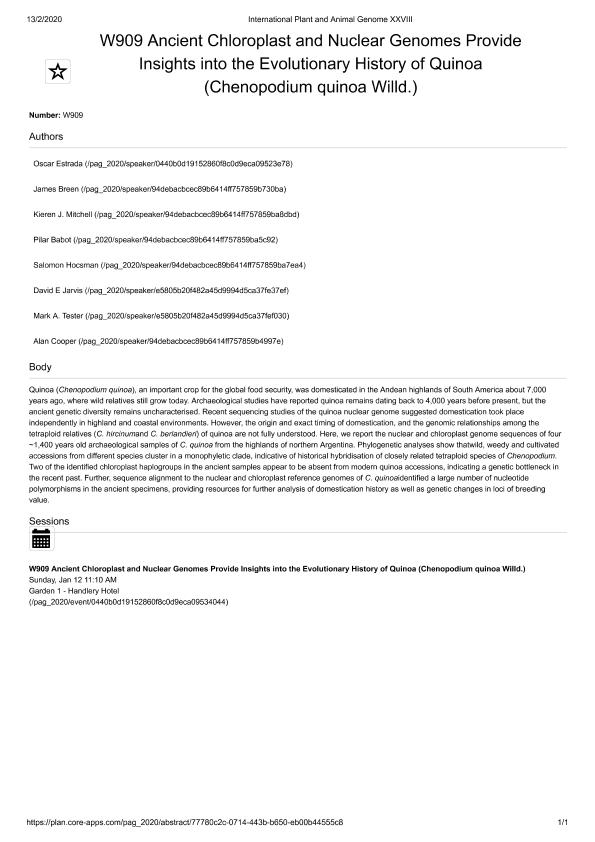Evento
Ancient chloroplast and nuclear genomes provide insights into the evolutionary history of quinoa (chenopodium quinoa willd.)
Estrada Santamarina, Oscar; Breen, James; Mitchell, Kieren J.; Babot, Maria del Pilar ; Hocsman, Salomón
; Hocsman, Salomón ; Jarvis, David; Tester, David; Cooper, Alan
; Jarvis, David; Tester, David; Cooper, Alan
 ; Hocsman, Salomón
; Hocsman, Salomón ; Jarvis, David; Tester, David; Cooper, Alan
; Jarvis, David; Tester, David; Cooper, Alan
Tipo del evento:
Conferencia
Nombre del evento:
Plant and Animal Genome Conference XXVII
Fecha del evento:
11/01/2020
Institución Organizadora:
International Plant and Animal Genome Conference;
Título del Libro:
Abstracts of Plant and Animal Genome Conference XXVII
Editorial:
Plan & Genome Plant Genome
Idioma:
Inglés
Clasificación temática:
Resumen
Quinoa (Chenopodium quinoa), an important crop for the global food security, was domesticated in the Andean highlands of South America about 7,000 years ago, where wild relatives still grow today. Archaeological studies have reported quinoa remains dating back to 4,000 years before present, but the ancient genetic diversity remains uncharacterised. Recent sequencing studies of the quinoa nuclear genome suggested domestication took place independently in highland and coastal environments. However, the origin and exact timing of domestication, and the genomic relationships among the tetraploid relatives (C. hircinumand C. berlandieri) of quinoa are not fully understood. Here, we report the nuclear and chloroplast genome sequences of four ~1,400 years old archaeological samples of C. quinoa from the highlands of northern Argentina. Phylogenetic analyses show thatwild, weedy and cultivated accessions from different species cluster in a monophyletic clade, indicative of historical hybridisation of closely related tetraploid species of Chenopodium. Two of the identified chloroplast haplogroups in the ancient samples appear to be absent from modern quinoa accessions, indicating a genetic bottleneck in the recent past. Further, sequence alignment to the nuclear and chloroplast reference genomes of C. quinoa identified a large number of nucleotide polymorphisms in the ancient specimens, providing resources for further analysis of domestication history as well as genetic changes in loci of breeding value.
Palabras clave:
QUINOA
,
ANCIENT DNA
,
ARCHAEOLOGICAL QUINOA
,
HIGHLANDS OF NORTHERN ARGENTINA
Archivos asociados
Licencia
Identificadores
Colecciones
Eventos(ISES)
Eventos de INST.SUPERIOR DE ESTUDIOS SOCIALES
Eventos de INST.SUPERIOR DE ESTUDIOS SOCIALES
Citación
Ancient chloroplast and nuclear genomes provide insights into the evolutionary history of quinoa (chenopodium quinoa willd.); Plant and Animal Genome Conference XXVII; San Diego; Estados Unidos; 2020; 1-1
Compartir



